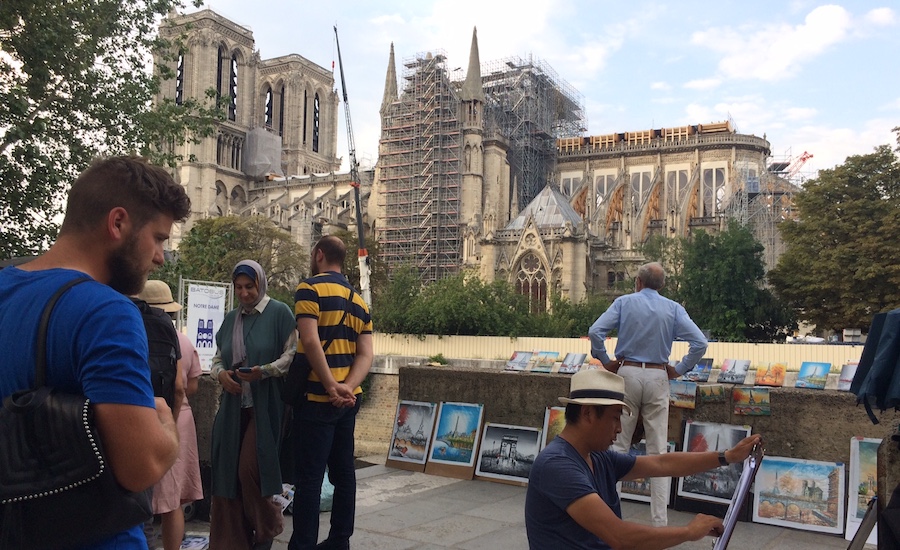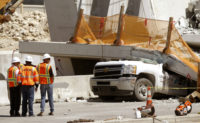Commentary on Environmental Transparency
Did Paris Disclose Truth About Lead After Notre Dame Fire?
A surprise during my recent vacation

A man gazes at the fire-wounded Cathedral Notre-Dame from across the Seine river. Photo: Richard Korman for ENR
The biggest issue related to April’s fire at Notre Dame cathedral in Paris isn’t the failure, documented in good newspaper stories, to respond quickly in the fire’s first hour. Or that lead ash rained down, although that is important.


The biggest issue is that fires, once feared for their ability to kill quickly, injure horrendously and destroy property, are now recognized as a possible longer-term threat to the lungs and brains and health of anyone who has contact with the smoke or ash. And whether the response to the environmental issues in Paris included enough notice to the public.
The Paris government’s curious lassitude on lead seemed part bureaucratic inertia and part unspoken desire to keep the tourists pouring into the city. One of them was me. Within minutes of hitting the hotel after an all-night flight in late August, the first thing I did was head toward the great cathedral. For no other reason than that Notre Dame is part of the beating heart of France.
 |
| A telecast in Paris of Mayor Emmanuel Grégoire reporting that the schools can re-open on time after the lead clean-up in the cathedral area had been completed. Photo: Richard Korman for ENR |
Knowing the building was closed, I wanted to know how close I could get. The answer was, very close, about 40 to 50 ft from the cathedral wall facing the narrow street with the souvenir shops, separated by a construction fence. I inserted myself into the steady stream of tourists passing alongside. We stopped to peer through fence openings and noticed the telescoping hydraulic crane and other equipment. But the building itself, its high haunches draped with scaffolding, overpowered the distractions of the fence and construction equipment. The famed buttresses were flying over us. The stone relief carvings claimed our gazes. Wonderful.
At the end of the street we turned to see the afternoon sun painting the main entrance façade gold. This was France’s Grand Canyon, and the tourist selfie sticks were up. Close to the cathedral sits the fortress-like Paris Prefecture Police Headquarters, where resistance fighters battled German soldiers in the city’s last long days of World War II occupation. I hummed “La Marseillaise.” And all around the Île de la Cité, and on the Left Bank of the Seine, busy battalions of tourists paid their respects, gawking, yes, but with some solemnity over the wounded Gothic wonder that dominated the cityscape near the river.
After touring the cathedral surroundings, that night back at the hotel the news flashed on a French TV station, “Plomb: La Rentrée N'est Pas Reportée (Lead: The Start of the School Year Is Not Postponed). All conditions for safe return of children have been met, said Paris Mayor Emmanuel Gregoire, standing before microphones with Deputy Mayor Anne Souyris.
 |
| Tourists and passersby jockey for positions from which to admire and photograph the facade of Notre Dame cathedral in Paris. Photo: Richard Korman for ENR |
Was I missing something dangerous in the air? I headed to the cathedral again, retracing my steps past the Shakespeare & Co. bookstore, to watch everyone watching the cathedral one more time. Out of easy public view, numerous schools and parks had been cleaned of any possible lead-ash. I never thought the problem was an issue beyond the immediate area of the cathedral.
Thanks to reporters we now know it was. Tests showed hirer lead levels up to three miles away from Notre Dame.
Alongside an excellent New York Times investigation of the lead issue, published September 15, was an adjoining story I would have liked to have read before my trip. The headline was, “How Dangerous Is Paris After the Cathedral Fire?” It concerned the lead that had settled on parks and plazas and other buildings.
One expert interviewed for the story said keep small children away—during my visits to the cathedral I passed many tourists hauling infants and leading grade-school kids. Another said don’t worry too much if you are a tourist. On reading that, my wise-cracking girlfriend, Susan, said that she thought something was amiss when the waiter at one bistro asked if we wanted to see “the regular or lead-free menu?” Jokes aside, there were no warnings at all. The city officials considered the streets safe even as they scrubbed the area schools. I hope they are right.
The Notre Dame cathedral fire of April 15 doesn’t rank with the great European fires of the past. But it does deserve a place in the history of environmental transparency.
Although I had read about the fire and the lead issues, and although crews had ostensibly cleaned the lead to a safe level appropriate to adults by the time we got to Paris, the city government posted no warning at all about any possible issue for children brought by tourists.
In retrospect, some warnings could have been issued for tourists with small children that allowed them to make decisions for themselves about entering the Notre Dame area. Their choices would have depended on parenting styles and their own assessment of the risks. Maybe just so they could keep an eye out for what the children touched.
Environmental paranoia? The cathedral and much of Central Paris are magnetic. Like me, most visitors, with plane tickets booked and hotels arranged, would have gone anyway even if we had been given the full story.




